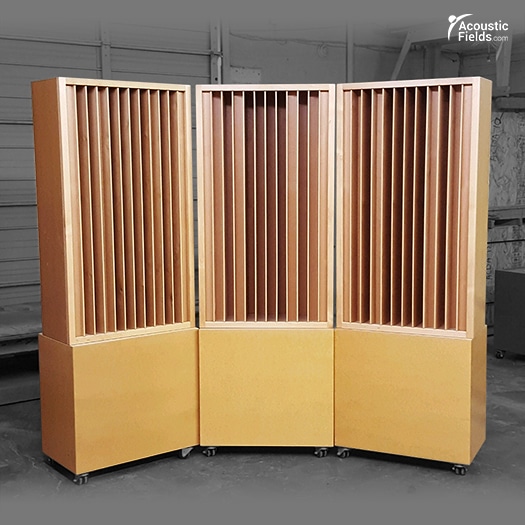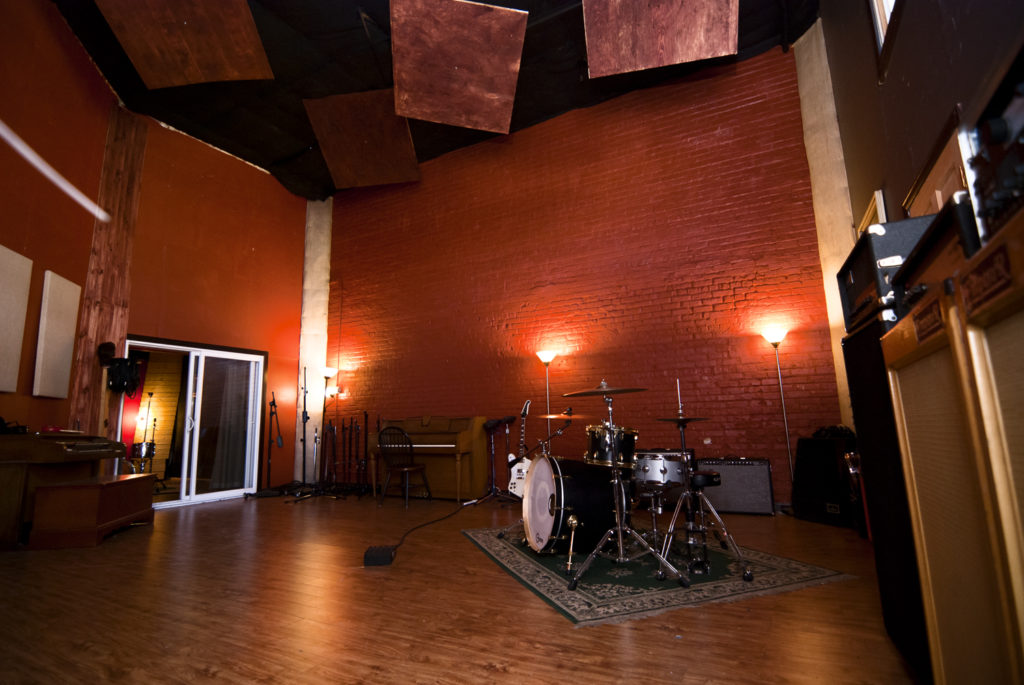In a recent hangout, I was asked a very long question which could best be summed up as “Should You Use Sound Diffusers In A Live Room?” The following video shows my answer as well as the full transcript of the video below. What is a “live” room? We have updated this blog to reflect updates in technology on 11/22/19.
Dennis: Okay, lots of information in this email, unfortunately, starting from the wrong premise. What is the frequency response of drums? What is the frequency response of a bass drum? Forty cycles. What is the frequency response of a snare? Sixty to Seventy. What is the frequency response of a snare? Eighty and above. What’s the lowest frequency you can get out of a diffuser? About a hundred, unless you build a diffuser 4 or 5-foot deep.
Drum Room
So are we using the right technology to deal with the sound source? Is diffusion the correct technology for a drum room? I don’t think so, not in this case because you don’t have the space to diffuse energy. Drum energy is never at a minimum level where you need diffusion to add more space, definition, and quantity too. There is always plenty of drum energy in any room I’ve ever been in. You can ask the drummer to play softer, but that usually never works in my experience.
I think here’s the case where we’re using diffusion improperly. We probably need to look for absorption in a drum room; low-frequency, middle-frequency and high-frequency because we have things above the snare, we have cymbals, cow-bells all kinds of percussion that are higher frequency generating devices. I don’t think diffusion in a drum room is something that we would look at.

Our Quadratic Diffuser with Base
Now that said, building one diffuser 2 by 4 feet, let’s assume 8 square feet won’t do anything for you. You have to cover much larger surface areas because it’s the surface area that creates the problem. So it’s the surface area that creates the solution if you apply the correct technology to the surface area. So I think a couple of issues here are not appropriate: one, using diffusion in a drum room.
Live Room Definition: https://en.wikipedia.org/wiki/Recording_studio
Ali: He said a live room.
Dennis: Well okay a live room can mean a lot of different instruments and a lot of different things. But if we’re using the live room mainly for drums and the room is very good sized. It was what did you say? Nine meters? So that’s twenty-seven feet.
Ali: Yeah, 4.6 wide and 3.3 meters tall.
Dennis: So we’ve got 12 x 10 x 25 (roughly 26), so a great volume, great dimensions. I would first be concerned with the low-frequency management issues in that room first. Always start at the low-end first. I see people constantly starting at the high-end and the middle-end and working their way down to the low-end. Don’t do that. Start with low-frequency management first in any room whether it’s a room you’re listening to music in, whether it’s a room you’re mixing and mastering in, whether it’s a room you’re recording in. Always start with the management of the low-end first.
Managing The Low End Is Key
Now I know managing low-frequency is not the sexiest thing in the world. You don’t need a diffuser which is a cool looking device, I get that. Low-frequency energy is about big boxes sitting around in certain places of the room that are really heavy, I get that too. But if you don’t get the low-frequency energy managed correctly in your room, the ‘mids’ and ‘highs’ won’t even matter because you won’t hear half of them if you’ve got so much pressure from the low-frequency end. So whenever someone is trying to add a lot of diffusion to a room surface I always have to go back to basics and say “Well have you got the low-end under control? Have you managed the low frequencies correctly? If you haven’t we really need to start there first.”
Ali: Good job, well and great video we’ve got coming up. You brought a local producer into our studio. Was it Saturday Joshua came in? I really enjoyed that; we’ll get that live for people soon but his reaction really spoke I think quite a lot to the element of the management of bass. I mean he looked quite overwhelmed at times quite emotional, it must be so. NB: you can see that video below as it has since been published.
Diffusion Link : https://www.acousticfields.com/product-category/sound-diffusion/qd-series/
Dennis: Well and then when I told him he was sitting right next to a 12-inch subwoofer that was operating at 80% of its capacity he really freaked out. He just thought that it was a table that you put your glass on but it was a subwoofer and I do that on purpose with people because people constantly fight with subwoofers. People say ‘I can’t get this subwoofer to integrate into my room; I can’t get the speed of the subwoofer to match the speed of my main speakers.’ Well yes, you can if the room is managed correctly, you can. When you sit in my studio you can.
I used to have two 12-inch subwoofers in there, side by side by the listening chair and you couldn’t tell they were on. So you can do it. Now that said, I have just added another thousand pounds of Activated Carbon, I now have 6,000 pounds of Carbon in the studio. You should hear my bass now. I didn’t think another thousand pounds would make that great of a difference but boy was I wrong. So much for live room acoustics.
There’s a Difference Between Theory and Application
Anyway, the bottom-line here is you can have all these things the literature tells you in theory but you’ve got to make the sacrifice in practice. You have to treat the room first and our studio, as everyone knows, is a square room of 18 x 18 x 8. If somebody came to me with that size room I’d tell them to run as fast as they could away from it because it’s a square. A square room creates way more problems than a rectangular room almost to the point of being untreatable. My room is untreatable and I did that on purpose because I can treat it. I can change the Physics in the room by using the right technology and our technology is that kind of technology.

Live Room for Drums
So our room, even though it’s a square, is flat down to 27 cycles. I don’t know any rooms that are that way and that’s what you hear when people react to the sound in the room. You hear all that low-frequency management. You hear that high and middle-frequency reverberation control blended with diffusion. So you hear everything in balance and you’ll hear everything in the recording.
When the room is balanced and you play good music with good resolution sources you’ll hear everything. But it’s not easy getting there and you have to make sacrifices. You have to use the correct technology to solve the issues you’re facing and it can be achieved. But at what price, at what cost and at what effort and time you want to do that? Live room acoustics take a lot of surface area coverage.
Well obviously I’m in the business so my goal is absolute, I mean I want to hear everything in that source. I know it’s there, I can hear glimpses of it every now and when the room pressure gets out of my way. In most rooms I can hear that faint cymbal, I can hear the way the guitar player walks-out of the break or walks into the break, I can hear that but I can’t really hear it, I can’t get a definition on it. That means that the room is in the way. I’ve got to get the room out of the way because I know the engineer and I know the guitar player played it and I know the engineer recorded it.
Why can’t I hear it? What’s the other missing link? The room! So you can do it, it can be done. The right technology, the right space, lots of patience and a huge desire to hear everything in the recording.
Ali: Great, I’ll post this back up to the person that sent that in. But I thought Joshua‘s video was great for that because he really enunciated from the position of being an engineer very well. What I heard I didn’t put into terms as he did so well. But you know it is an emotional, incredible emotional connection in that room because you just do feel like you’re part of the band. It’s actually the biggest problem I think we currently have to try to explain to people what that experience is because it is an experience and how do you explain to anybody what an experience is, it’s personal. Anyway, so I’m rambling.
Dennis: No it’s okay. I wish I could bring everyone that’s watching today, I wish I could bring you all here to the studio. I wish I could put you all in the chair and I would press the play button and I would leave the room and it would be just you and the music and if you brought your own music, it would be you and your music. And isn’t that what we want? Don’t we want just us and our music? We don’t want the room adding its stink. We don’t want the room contributing anything.
I Want the Room to Go Away.
I want the walls, the floor, and the ceiling to vanish. Well in order to get them to acoustically vanish and fool my ears and my brain I have to put things on those surfaces. I have to fill the room with a certain amount of low-frequency absorbing devices and more importantly, I have to do it in the right places. And once you do that and get it right, there’s nothing like it, there’s just nothing like it and I wish there was a way to do it (get everyone here).
We struggle trying to communicate to people what the room really sounds like and when you watch Joshua’s video when you watch some of our past people, I think you get it. I had a customer in here the other night, he was mad. He was really upset, he left mad not because of anything I did but because he’d spent tens of thousands of dollars on gear and didn’t have, what was his word: “I don’t have 25% percent of the sound quality you have and you’re using $400 worth of gear.” He goes “I’m really upset,” he says “I’m not mad at you,” he says “I’m glad you’re opening my eyes but it’s not about the gear is it?” I said “No it’s not. It’s partially about the gear because you have to have a minimum quality level to begin with” But amplifier and speaker electronics have come a long way, we don’t, you don’t need to spend tons of money on the gear today but you do need to spend money on room treatment because the room is a speaker just like the speakers that you put in it and you got to make those two speakers work.
It’s like having three people in the kitchen cooking a meal that never works. You’ve got to have one cook, one source. So you can’t have your speakers and your amplifier in the room all contributing to the final sound that you hear. You’ve got to have just one thing and that’s the speakers making the sound energy that you hear. The amplifier, the room, the cables, all that has got to go away and then when you have a room like mine the speakers then go away too and you just have a room that has sound in it.
In Summary
I hope this discussion was useful to you. If you would like your room acoustic issues analysed for free by me then please fill in the form here and I will be happy to take a look for you.
Thanks
Dennis







